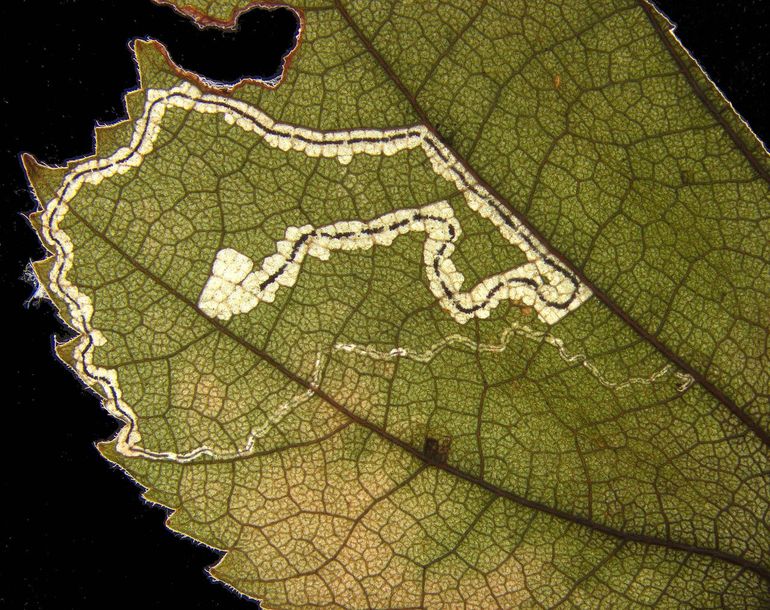
The quick rise of the leafmining moth Stigmella naturnella in Europe
Naturalis Biodiversity CenterIt was only in 2020 that the birch leafminer (Stigmella naturnella) became known to occur in the Netherlands and Belgium, thanks to online photos of leafminers. Erik van Nieukerken, butterfly researcher at Naturalis Biodiversity Centre managed to recognise them and was able to find the species himself in much of the Netherlands. Thanks in part to many observations on Waarneming.nl and Waarnemingen.be, some of which were re-determined, the rapid establishment and expansion in our country, but also across Europe, could be recorded and reconstructed.
Leaf miners
Stigmella naturnella is a very small moth, barely longer than 2 mm at rest, whose caterpillars make characteristic leaf mines in birch leaves. Many species of leaf miners are known to occur on birch in the Netherlands, six of which belonging to the genus Stigmella. The leaf mines of all these species share the long corridors, winding or not, with a trail of frass in the centre. The species differ by a combination of characteristics such as width of the frass trail, angularity of the mine, location of the egg and position of the exit slit through which the caterpillar leaves the mine; the colour of the caterpillar and presence of visible ganglia are also characteristic.

Despite the availability of identification keys, leaf mines on birch were often misidentified. This prompted the author to include a modified identification key for these leaf mines. An added complication here is that the two Stigmella species specialised on alder (Alnus) also occasionally occur on birch, as Erik was able to determine from specimens whose DNA barcode had been analysed. In fact, such leaf mines had not yet been described anywhere, but those of Stigmella glutinosae, in particular, are quite similar to those of Stigmella naturnella, and these species were often found together on birch, especially in France and Russia.
Occurrence and expansion
Stigmella naturnella was described as recently as 1936 from South Tyrol in northern Italy and named after the town Naturno. Until recently, almost all records came from central Europe, often warmer places and valleys, giving the species the label 'thermophilous’. As of the early 2000s, it was already clear that the species occurs across much of Russia (as far away as Japan!), and from the 2010s some more northerly sightings were made in Germany and Poland. Through a study of old herbarium material, uncertain observations from Hamburg and Berlin from the 1930s could be labelled as incorrect, but legacy records from Stuttgart proved correct.
By looking at the many sightings of all birch miners on waarneming.nl and waarnemingen.be, Erik could see that the first records from the Netherlands and Belgium were from 2017. In 2020, the species appeared to occur as far North as the middle Veluwe and in 2022 the northern border was in northern Overijssel. As detailed searches for leaf miners have been carried out in our country in particular for a very long time and old collections did not yield any new finds, we can assume that the establishment really only took place very recently and we thus can consider this a rapid expansion.

Advance
In Germany, there is much less interest in leaf miners, but even there the species was found new after 2010 in Bavaria, Saxony, Brandenburg, Saarland and North Rhine-Westphalia. The only old known records were from Baden-Württemberg. Along with the new records from the Netherlands, Belgium and France, S. naturnella is also reported for the first time from Croatia and Ukraine.
Stigmella naturnella seems to have started its spread only in the 2000s, from central Europe both to the northwest, and to the north (eastern Germany, Poland). It seems that all western European specimens have roughly the same DNA barcode, those from eastern Europe a slightly different one, and that most DNA variation is found in Russia. This suggests a post-Ice Age expansion from Russia. It is still unclear whether the species only arrived in the alpine region relatively recently, or has been there for a long time. 
Causes?
As in many southern species, climate change seems to be the main cause of the spread of Stigmella naturnella. The species may have an advantage due to the occurrence of multiple annual generations, as adults can occur throughout the year, expansion can occur when weather conditions are favourable, e.g. during strong southerly winds. Other species are more limited by their shorter flight period. Wintering moths were also found quite often in cities, under bark of London plane, far from the birches they normally live on, another indication of expansion. Cities are also warmer in winter than the outlying areas. Within the family of pygmy moths (Nepticulidae), to which this species belongs, usually the caterpillars or pupae overwinter in a cocoon, only two Dutch species do so as adult.
Could this species compete with other species? It seems unlikely, given the relatively low densities, but competition cannot be completely ruled out a priori, not least because probably not all birch leaves are equally suitable for the caterpillars. It does seem that the more northern species like Stigmella lapponica and Stigmella confusella are becoming less common in the Netherlands, but further research into this is needed.
More information
• Read the scientific paper online: Stigmella naturnella (Klimesch, 1936) (Lepidoptera, Nepticulidae) a fast-spreading European leafminer of Betula, with a revised key to linear leafmines on Betula.
• Specimen data of the fast spreading leafminer Stigmella naturnella (Nepticulidae) in Europe (GBIF dataset)
• New leafminer butterfly on birch already common in much of the Netherlands.
Text: Erik van Nieukerken, Naturalis Biodiversity Center
Photos: Gerwin van de Maat (lead photo: female southern birch leafminer); Erik van Nieukerken
